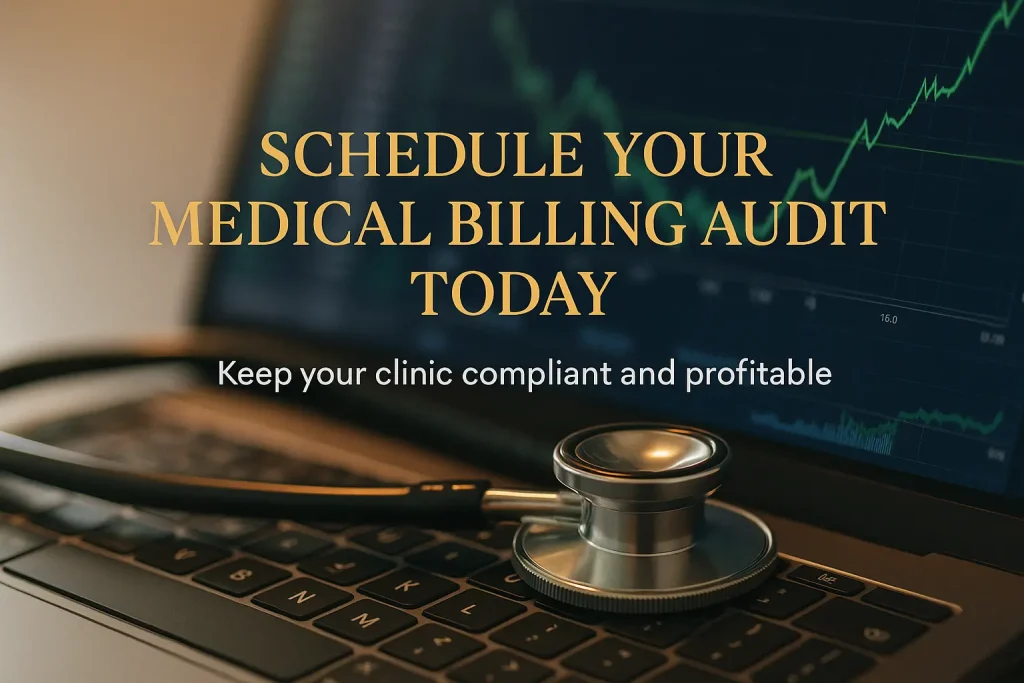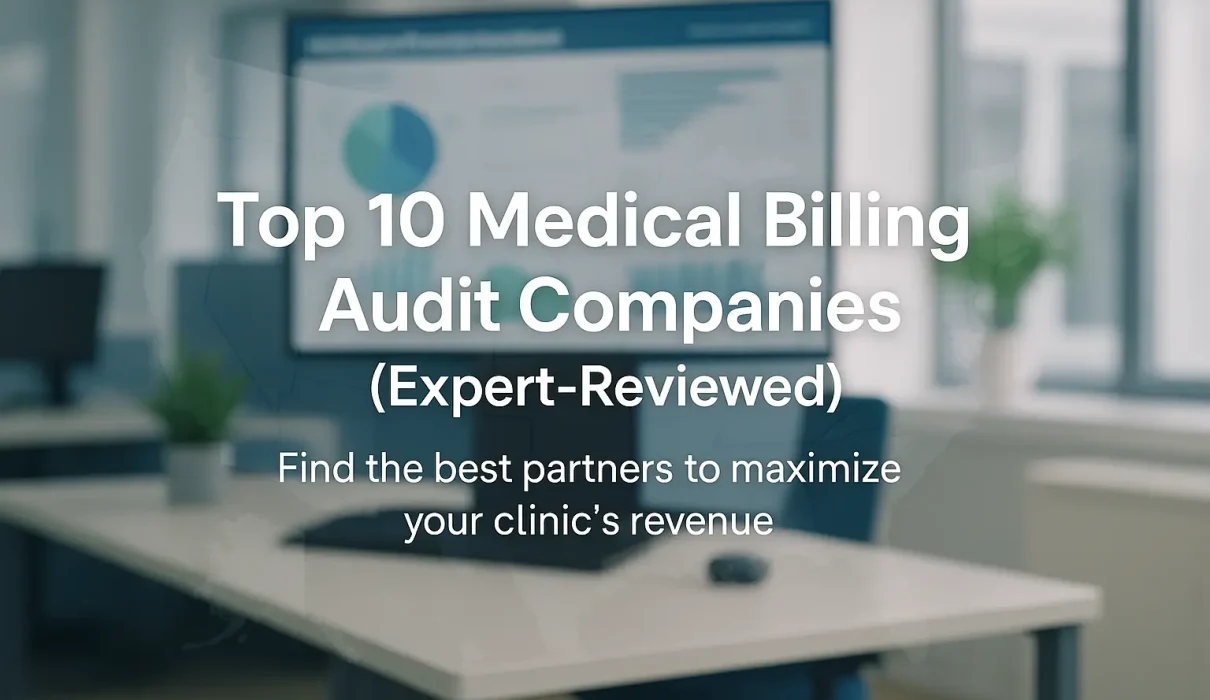Introduction
In today’s healthcare world, every dollar counts. Hospitals and clinics work hard to take care of patients — but when billing mistakes happen, they lose time and money. Studies show that more than 80% of medical bills contain some kind of error, leading to delayed payments or claim denials.
That’s why medical billing audits are so important. A proper audit helps healthcare providers find billing problems early and fix them before they affect revenue. It also makes sure everything follows the rules of HIPAA, CMS, and insurance companies.
In this article, we’ll share the 10 Best Medical Billing Audit Companies in the USA (Expert-Reviewed). These companies have been selected for their accuracy, technology, experience, and trustworthiness.
Whether you manage a private clinic, a large hospital, or a small healthcare business, this list will help you find the perfect partner to keep your billing process clean and efficient.
What Is a Medical Billing Audit?
A medical billing audit is a detailed check-up of your clinic’s billing system. Just like doctors examine patients, billing experts review your billing records to find and fix errors.
It includes:
- Checking billing codes and patient information.
- Finding missing or incorrect charges.
- Making sure insurance claims follow the latest regulations.
- Identifying revenue leakage and improving payment speed.
There are two main types of audits:
- Internal Audits: Done by your clinic’s own billing team.
- External Audits: Done by professional billing companies that specialize in detecting mistakes and improving overall efficiency.
A good audit keeps your clinic compliant, financially healthy, and free from billing headaches.

Why Medical Billing Audits Are Important
Billing audits are more than just error-checking they’re about making your business stronger. Here’s why they matter:
1. Prevent Revenue Loss
Errors in billing can lead to denied claims, unpaid bills, or underpayments. Regular audits help catch these early.
2. Save Time and Effort
Instead of spending hours fixing rejections, audits ensure claims are clean before submission.
3. Stay Compliant
Billing laws change frequently. It also makes sure everything follows the rules of HIPAA compliance standards and CMS billing guidelines.
4. Improve Accuracy
Accurate billing builds trust with patients and insurance providers.
5. Boost Clinic Reputation
When your billing is clean and transparent, your clinic’s reputation grows stronger.
How We Selected the Top 10 Companies
We reviewed over 50 medical billing companies across the United States.
Here’s what we looked at before choosing the best 10:
- Accuracy Rate: Claim success and denial reduction.
- Technology Use: AI, automation, and data analytics.
- Compliance: HIPAA, CMS, ISO certifications.
- Experience: Years in business and client success stories.
- Customer Feedback: Ratings, testimonials, and overall satisfaction.
After analysing all these factors, here are the 10 companies that truly stand out.
10 Best Medical Billing Audit Companies in the USA (Expert-Reviewed)
1. Medmax Technologies
Headquarters: New York, NY
Best For: Large hospitals and multi-specialty clinics
Medmax Technologies tops our list because of its AI-powered billing audit solutions. They use automation and analytics to detect billing errors and ensure compliance with all U.S. healthcare standards.
Key Features:
- 98% claim acceptance rate
- 24/7 billing support
- HIPAA and ISO 27001 certified
- Advanced dashboards for audit tracking
Their expertise in revenue cycle management (RCM) makes them a trusted partner for healthcare organizations across the country. Medmax is especially great for hospitals looking to handle high claim volumes efficiently.
2. CureMD
Headquarters: New York, NY
Best For: Clinics that want integrated software and auditing
CureMD offers both medical billing services and EHR software, giving you a complete view of your financial health. Their system automatically finds coding and claim submission mistakes before they cause delays.
Why Choose CureMD:
- Built-in error alerts
- Easy-to-use software
- Secure cloud storage
- Suitable for clinics of all sizes
CureMD is perfect for healthcare providers that want a single, all-in-one platform for billing, auditing, and patient management.
3. Athenahealth
Headquarters: Boston, MA
Best For: Hospitals that rely on technology-driven solutions
Athenahealth combines automation and human expertise to deliver accurate billing audits. Their AI models detect issues like missing codes, incorrect charges, or duplicate claims.
Features:
- Real-time reporting
- Excellent EHR and practice management tools
- Cloud-based system for quick access
- Dedicated client success teams
Athenahealth is a great option for large hospitals and healthcare networks that want scalability and automation.
4. AdvancedMD
Headquarters: South Jordan, Utah
Best For: Clinics that need automation and transparency
AdvancedMD is known for its cloud-based billing audits. They focus on helping practices monitor revenue flow and spot errors using an interactive dashboard.
Highlights:
- 99% clean claim submission rate
- Monthly audit reports
- Automated claim tracking
- Easy integration with most EHRs
Their platform is user-friendly, making it ideal for clinics that want to save time and improve accuracy without extra training.
5. CareCloud
Headquarters: New Jersey, USA
Best For: Multi-specialty medical groups
CareCloud offers advanced billing and audit services with strong technology support. They focus on error prevention, not just error detection.
Top Features:
- Predictive analytics for claim accuracy
- 40+ EHR integrations
- Real-time performance dashboard
- 97% claim success rate
CareCloud is especially popular among mid-size clinics that handle patients from multiple specialties.

6. iRCM Inc.
Headquarters: Brooklyn, NY
Best For: Small clinics and local healthcare practices
iRCM provides personalized billing audit solutions with a strong focus on customer support. Their experts review every claim carefully to reduce rejections and improve turnaround time.
Why Choose iRCM:
- 24/7 support for clients
- HIPAA and CMS compliant
- 98% accuracy in audit reporting
- Friendly for smaller practices
They’re one of the few companies that provide both on-site and remote support, making them a flexible option for local providers.
7. SybridMD
Headquarters: Illinois, USA
Best For: Hospitals and nationwide healthcare organizations
With over a decade of experience, SybridMD is a leader in medical billing audits and revenue cycle management. Their team combines technology and human expertise to deliver top-notch accuracy.
Key Highlights:
- Works in 22+ states
- 97% clean claim ratio
- HIPAA-certified team
- Affordable pricing options
They’re ideal for providers who want long-term partnerships and continuous improvement in billing efficiency.
8. Kareo
Headquarters: California, USA
Best For: Small healthcare startups or solo practitioners
Kareo offers simple, cost-effective billing audit services. Their easy-to-use software makes it possible for even small clinics to manage billing smoothly.
Advantages:
- Low-cost packages
- Real-time tracking
- Simple reporting interface
- Excellent customer service
Kareo’s focus is on making medical billing and audits stress-free and affordable for small healthcare teams.
9. Revele
Headquarters: Indianapolis, IN
Best For: Data-driven healthcare practices
Revele stands out for its focus on analytics-based auditing. They use advanced data tools to identify patterns in billing errors and reduce account receivable (AR) days.
Main Features:
- AI-powered audit reports
- In-depth denial management
- Easy-to-understand analytics
- Great for clinics that need insights
They’re a great match for practices that want actionable audit data and measurable financial improvements.
10. Medwave
Headquarters: Pennsylvania, USA
Best For: Full-service billing and audit management
Medwave provides complete solutions, from billing to auditing and compliance checks. Their goal is to help clinics avoid costly mistakes and improve cash flow.
Why Medwave Is Trusted:
- Quick turnaround for claims
- Automated claim tracking
- HIPAA and ISO certified systems
- Fast and transparent communication
Their team helps healthcare providers simplify billing, avoid errors, and get paid faster all in one service.

Benefits of Hiring a Medical Billing Audit Company
Still wondering why outsourcing your billing audits is a good idea?
Here’s how it helps:
- Fewer Mistakes: Experts spot errors before submission.
- Faster Payments: Clean claims get processed more quickly.
- Higher Profits: You recover missed or denied payments.
- Less Stress: Your staff can focus on patient care, not paperwork.
- Better Reports: Regular updates keep you informed.
- Full Compliance: Stay aligned with laws and payer requirements.
Outsourcing your audits means your practice runs smoother, faster, and safer.
How to Choose the Right Medical Billing Audit Partner
Finding the right company is key.
Before signing a contract, check the following:
- Experience: Choose a company with a strong track record.
- Certifications: Make sure they follow HIPAA and CMS standards.
- Technology: AI and automation improve speed and accuracy.
- Reports: Look for transparent reporting and dashboards.
- Support: 24/7 helpdesk is always a big plus.
- Reviews: Read what other clinics say about their service.
Also, request a free audit demo before you finalize your choice this helps you understand how they work and what results to expect.
Tips from Industry Experts
“Even one small error in coding can cost hundreds of dollars. A proper audit finds those mistakes before they multiply.”
— Dr. Samuel Ryan, Healthcare Finance Consultant
“Automation is the future of billing audits. Choose companies that mix human skill with AI tools.”
Mary Allen, Medical Compliance Trainer
These insights remind us that a reliable audit system doesn’t just protect revenue it ensures long-term growth.
Quick Comparison Table
| Rank | Company | Best For | Key Feature | Claim Accuracy |
|---|---|---|---|---|
| 1 | Medmax Technologies | Large hospitals | AI audit tools | 98% |
| 2 | CureMD | EHR users | All-in-one system | 97% |
| 3 | Athenahealth | Large networks | Machine learning | 96% |
| 4 | AdvancedMD | Mid-size clinics | Cloud automation | 99% |
| 5 | CareCloud | Multi-specialty | Predictive analytics | 97% |
| 6 | iRCM Inc. | Local practices | 24/7 support | 98% |
| 7 | SybridMD | Multi-state orgs | Cost-efficient | 97% |
| 8 | Kareo | Small clinics | Affordable pricing | 96% |
| 9 | Revele | Data-focused | Smart analytics | 97% |
| 10 | Medwave | Full-service RCM | Fast claims | 95% |

Frequently Asked Questions (FAQs)
1. What do medical billing and coding companies do?
Medical billing and coding companies help healthcare providers get paid correctly and on time. They convert patient treatments into standard medical codes, create bills, and send claims to insurance companies. This process makes sure every service a doctor provides is billed properly and follows all government and insurance rules.
2. What are medical billing services?
Medical billing services include preparing, submitting, and managing insurance claims for healthcare providers. These services handle tasks like verifying patient information, coding procedures, tracking payments, and managing denied claims. Their main goal is to help clinics and hospitals reduce billing errors and improve revenue collection.
3. What are medical billing audit services?
Medical billing audit services check a clinic’s billing process to find mistakes and fix them before they cause revenue loss. Auditors review claim records, coding accuracy, and compliance with HIPAA and CMS guidelines. These services help identify underpayments, reduce claim rejections, and ensure healthcare organizations follow all billing regulations.
4. Why should I hire a medical billing company?
Hiring a medical billing company saves time, reduces stress, and ensures you get paid faster. These companies handle all the complex paperwork, coding, and claim submissions. They also keep your clinic compliant with healthcare laws, which reduces financial risks and allows you to focus more on patient care instead of billing problems.
Final Thoughts
Choosing the right medical billing audit company is one of the most important decisions for any healthcare provider. It’s not just about fixing mistakes it’s about building a system that’s strong, compliant, and profitable.
The companies listed here have all been expert-reviewed for their performance, accuracy, and technology use. They’ve helped thousands of clinics across the USA save time, reduce costs, and improve revenue collection.
If your clinic struggles with claim denials, delayed payments, or compliance issues, it’s time to get professional help. With the right audit partner, your practice can finally focus on what truly matters taking care of patients.
To learn how AI-driven billing audits can transform your revenue cycle, visit Fexoi’s medical billing solutions or explore the Fexoi blog for expert tips and industry insights.







